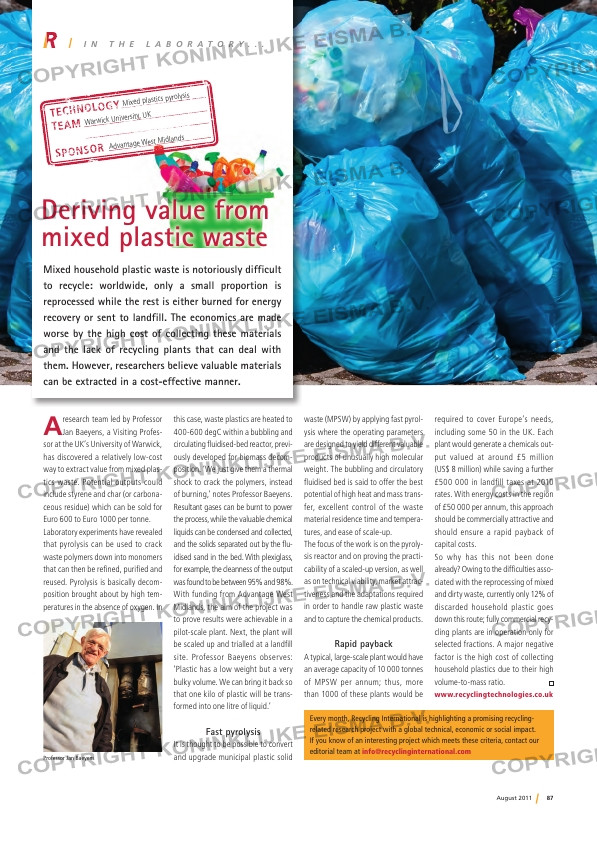Page 87 from: August 2011

87August 2011
I N T H E L A B O R A T O R Y . . .
required to cover Europe’s needs,
including some 50 in the UK. Each
plant would generate a chemicals out-
put valued at around £5 million
(US$ 8 million) while saving a further
£500 000 in landfill taxes at 2010
rates. With energy costs in the region
of £50 000 per annum, this approach
should be commercially attractive and
should ensure a rapid payback of
capital costs.
So why has this not been done
already? Owing to the diffi culties asso-
ciated with the reprocessing of mixed
and dirty waste, currently only 12% of
discarded household plastic goes
down this route; fully commercial recy-
cling plants are in operation only for
selected fractions. A major negative
factor is the high cost of collecting
household plastics due to their high
volume-to-mass ratio.
www.recyclingtechnologies.co.uk
Every month, Recycling International is highlighting a promising recycling-
related research project with a global technical, economic or social impact.
If you know of an interesting project which meets these criteria, contact our
editorial team at [email protected]
A research team led by Professor Jan Baeyens, a Visiting Profes-
sor at the UK’s University of Warwick,
has discovered a relatively low-cost
way to extract value from mixed plas-
tics waste. Potential outputs could
include styrene and char (or carbona-
ceous residue) which can be sold for
Euro 600 to Euro 1000 per tonne.
Laboratory experiments have revealed
that pyrolysis can be used to crack
waste polymers down into monomers
that can then be refi ned, purifi ed and
reused. Pyrolysis is basically decom-
position brought about by high tem-
peratures in the absence of oxygen. In
waste (MPSW) by applying fast pyrol-
ysis where the operating parameters
are designed to yield different valuable
products of unusually high molecular
weight. The bubbling and circulatory
fl uidised bed is said to offer the best
potential of high heat and mass trans-
fer, excellent control of the waste
material residence time and tempera-
tures, and ease of scale-up.
The focus of the work is on the pyroly-
sis reactor and on proving the practi-
cability of a scaled-up version, as well
as on technical viability, market attrac-
tiveness and the adaptations required
in order to handle raw plastic waste
and to capture the chemical products.
Rapid payback
A typical, large-scale plant would have
an average capacity of 10 000 tonnes
of MPSW per annum; thus, more
than 1000 of these plants would be
this case, waste plastics are heated to
400-600 degC within a bubbling and
circulating fl uidised-bed reactor, previ-
ously developed for biomass decom-
position. ‘We just give them a thermal
shock to crack the polymers, instead
of burning,’ notes Professor Baeyens.
Resultant gases can be burnt to power
the process, while the valuable chemical
liquids can be condensed and collected,
and the solids separated out by the fl u-
idised sand in the bed. With plexiglass,
for example, the cleanness of the output
was found to be between 95% and 98%.
With funding from Advantage West
Midlands, the aim of the project was
to prove results were achievable in a
pilot-scale plant. Next, the plant will
be scaled up and trialled at a landfi ll
site. Professor Baeyens observes:
‘Plastic has a low weight but a very
bulky volume. We can bring it back so
that one kilo of plastic will be trans-
formed into one litre of liquid.’
Fast pyrolysis
It is thought to be possible to convert
and upgrade municipal plastic solid
Mixed household plastic waste is notoriously difficult
to recycle: worldwide, only a small proportion is
reprocessed while the rest is either burned for energy
recovery or sent to landfill. The economics are made
worse by the high cost of collecting these materials
and the lack of recycling plants that can deal with
them. However, researchers believe valuable materials
can be extracted in a cost-effective manner.
TECHNOL
OGY
TEAM
SPONSOR
Mixed plasti
cs pyrolysis
Warwick Un
iversity, UK
Advantage W
est Midlands
Deriving value from
mixed plastic waste
Professor Jan Baeyens
p087_In the laboratory.indd 87 05-08-11 09:24



